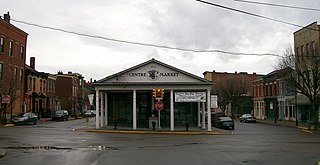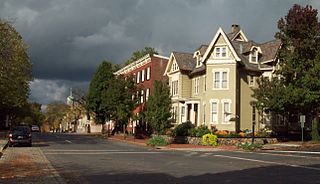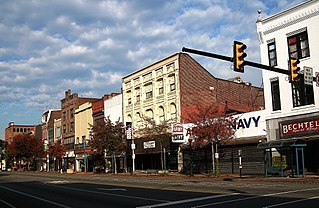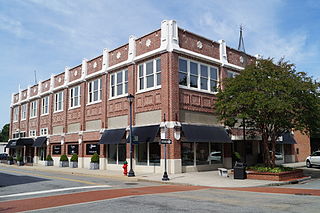
The Hinton Historic District is a national historic district located at Hinton, Summers County, West Virginia. The original Hinton Historic District is bordered roughly by the Chesapeake and Ohio Railroad line, James Street, 5th Avenue, and Roundhouse. The boundary increase extended the district to include Mill Street. It was listed on the National Register of Historic Places in 1984 and revised in 2005.

Downtown Huntington Historic District is a national historic district located at Huntington, Cabell County, West Virginia. The original district encompassed 59 contributing buildings; the boundary increase added 53 more contributing buildings. It includes the central business district of Huntington, and includes several of its municipal and governmental buildings. It contains the majority of the historic concentration of downtown commercial buildings. Notable buildings include the Huntington City Hall, Johnson Memorial Church (c.1886/1912/1935), Trinity Episcopal Church (1882), Davis Opera House, Love Hardware Building, Reuschleins Jewelry building (1923), the Newcomb Building, the Morrison Building (1919), Keith-Albee Theater (1928), West Virginia Building, and Gideon Building. Located in the district are the separately listed Carnegie Public Library, Cabell County Courthouse, U.S. Post Office and Court House, and Campbell-Hicks House.

Centre Market Square Historic District is a historic district in Wheeling, West Virginia, listed on the National Register of Historic Places.

Central Bethlehem Historic District is a national historic district located in Bethlehem in Lehigh and Northampton counties in the Lehigh Valley metropolitan area of eastern Pennsylvania.

Downtown Altoona Historic District is a national historic district located at Altoona, Blair County, Pennsylvania. The district includes 240 contributing buildings in the central business district and surrounding residential areas of Altoona. The buildings were primarily built after about 1860 and include residential, civic, social, and religious buildings. Although it does not encompass the entire downtown, it is for the most part the most urban part of Altoona's downtown district. Notable buildings include the Cathedral of the Blessed Sacrament (1920s), First Methodist Episcopal Church, First Presbyterian Church, First Evangelical Lutheran Church (1896-1897), U.S. Post Office (1931-1933), Fraternal Order of Eagles Building (demolished), Altoona City Hall, Casanave Building (1890s), Hutchison Block, McCrory's Department Store (1937), and Aaron-Penn Furniture Building. Located in the district are the separately listed Central Trust Company Buildings, Mishler Theatre, and Penn Alto Hotel.

Etna Furnace, also known as Mount Etna Furnace, Aetna Furnace, and Aetna Iron Works, is a historic iron furnace complex and national historic district located at Catharine Township, Blair County, Pennsylvania. The district includes five contributing buildings, six contributing sites, and two contributing structures. It encompasses a community developed around an iron furnace starting in 1805. Included in the district is the four-sided stone furnace (1808), gristmill site, canal locks, site of lock keeper's house, aqueduct, two small houses, the ruins of a charcoal house (1808), the foundation of a tally house, a blacksmith shop, bank barn, foundation of a boarding house, three family tenant house, two iron master' mansions, a store and paymaster's office, Methodist / Episcopal Church (1860), and cemetery with graves dating between 1832 and 1859.

Old Downtown Harrisburg Commercial Historic District is a national historic district located at Harrisburg, Dauphin County, Pennsylvania. The district includes 50 contributing buildings in the old central business district of Harrisburg and dating from the late-19th and early-20th centuries. Notable buildings include the Daily and Weekly Telegraph Building (1873-1874), City Bank Building, F.W. Woolworth (1939), Rothert's Furniture Store (1906), Bowman's Department Store, Pomeroy's Department Store, and Doutrich's Clothing Store. Located in the district and listed separately are the Colonial Theatre, Keystone Building, Kunkel Building, and the William Seel Building. The Telegraph Building was delisted after having been demolished.

Uptown Somerset Historic District is a national historic district located at Somerset in Somerset County, Pennsylvania. The district includes 190 contributing buildings, 1 contributing site, and 1 contributing object. It encompasses an area centered on the county government complex and Somerset County Courthouse, with the surrounding commercial district, residential areas, and cemetery. Notable buildings include the former Somerset Trust Company Building (1906), First National Bank (1922), County Jail and Sheriff's Residence, Lansberry House (1869), Edward Scull House (1847), former Somerset Academy (1882), Printing House Row (1872), St. Paul's United Church of Christ (1887), IOOF Building (1889), and First Christian Church (1909-1912).

Uniontown Downtown Historic District is a national historic district located at Uniontown, Fayette County, Pennsylvania. The district includes 113 contributing buildings and 1 contributing site in the central business district of Uniontown. Most of the contributing buildings were built between 1881 and 1932, and are representative of a number of popular architectural styles including Classical Revival, Moderne, Late Victorian, and Georgian. Twenty-two buildings date between 1811 and 1860. Notable buildings include the Fayette Bank Building (1902), Thompson-Ruby Building (1900), Highland House (1890), State Music Hall (1922), Exchange Hotel (1891), Galltin Apartments (1929), Gallatin Bank Building (1924), Federal Building (1930), Fayette County Courthouse (1892), County Building (1927), Central School (1916), and St. Peter's Episcopal Church (1884).

Mercersburg Historic District is a national historic district centered on the center square of Mercersburg in Franklin County, Pennsylvania. The district includes 124 contributing buildings and 1 contributing site in the central business district and surrounding residential areas of Mercersburg. The residential buildings include a number of sheathed log, stone, and brick dwellings, with some dating to the 18th century. The district has a number of notable examples of the Federal, Greek Revival, and Colonial Revival styles.

Marietta Historic District is a national historic district located at Marietta, Lancaster County, Pennsylvania. The district includes 373 contributing buildings in the central business district and surrounding residential areas of Marietta. The district includes notable examples of the Italianate and Federal architectural styles. Notable buildings include the Duffy House, Marietta Community Center, Shelly House, the Pierre de Vittry House, Marietta Theater, First Farmers' Bank, David Smith House, English Presbyterian Church, Liquor Control Board Office, the Railroad Hotel, Union House Gallery, Eckmans Hotel, White Swan Inn, Henry Musselman House, former Grove Hotel, and the Old Town Hall.

Lancaster Historic District, also known as Old Town Lancaster, is a national historic district located at Lancaster, Lancaster County, Pennsylvania. It includes 578 contributing buildings in a predominantly residential area of Lancaster, with buildings mostly dated between about 1840 and 1910. The district includes a few buildings dated to the 18th century. Residential buildings include two- and three-story Victorian brick rowhouses. Notable non-residential buildings include the Demuth's Tobacco Shop, St. James Episcopal Church, and the Unitarian Universalist Church of Lancaster. Also located in the district is the separately listed Lancaster County Courthouse designed by noted Philadelphia architect Samuel Sloan (1815–1884).

Old Pottstown Historic District is a national historic district located in Pottstown, Montgomery County, Pennsylvania. It encompasses 956 contributing buildings and 1 contributing site in the central business district and surrounding residential areas of Pottstown. The district includes a variety of residential buildings including workers' home and residences of prominent and wealthy citizens in a variety of architectural styles including Late Victorian, Gothic Revival, and Federal. This includes the separately listed Pottsgrove Mansion. Notable non-residential buildings include the Italianate style commercial buildings on High Street, 1725 Roller Mills, Reading Railroad station (1928), Doehler-Jarvis castings plant, Light Foundry building (1880), Ecker Building, Weitzenkorn Building, Security Trust Building (1888), Elks Home (1896), Pottstown Library (1920), Pottstown Borough Hall (1924), Masonic Temple (1926), Christ Episcopal Church (1872), First Methodist Church (1869), and St. Aloysius Roman Catholic Church (1891). Also in the district is the Searles Memorial Methodist Church (1911) designed by architect Joseph Miller Huston (1866–1940).

Upper Roxborough Historic District is a national historic district located in Philadelphia and Whitemarsh Township, Montgomery County, Pennsylvania. It encompasses 108 contributing buildings, 23 contributing sites, and 18 contributing structures in Upper Roxborough. The district includes a number of small scale farm and industrial workers' housing, estate houses, mill-owners' dwellings, and farm buildings. Notable buildings include the Shawmont Railroad Station (1834), Miquon Station designed by Frank Furness (1910), Riverside Paper Mills, Hagy's Mill ruin, St. Mary's Church, and "Fairview" and other buildings on the grounds of the Schuylkill Center for Environmental Education. The Roxborough Pumping Station was also part of the district, but it was demolished in 2011 after sitting abandoned for over fifty years.

Newtown Historic District is a national historic district located in Newtown, Bucks County, Pennsylvania. The district includes 293 contributing buildings in the borough of Newtown. They date from the late-17th century to the early-20th century and are reflective of a number of popular architectural styles including Greek Revival, Late Victorian, Federal, Queen Anne, and Gothic Revival. Notable buildings include the Chapman Buckman House and mill, Hart House, Newtown Hardware House, Keller Building, Jenks House (1828), White Hall Hotel, Temperance House (1774), Smock House (1792), the Brick Hotel, St. Luke's Church, LaRue Apartments (1838), and the Edward Hicks House. Located in the district and listed separately are the Half-Moon Inn and Friends Meeting House. It was added to the National Register of Historic Places in 1979, with two boundary increases in 1986.

Central Shelby Historic District is a national historic district located at Shelby, Cleveland County, North Carolina. It encompasses 229 contributing buildings in the central business district and surrounding residential areas of Shelby. The district is centered on the Cleveland County Courthouse (1907) and public square, established in 1841. The district includes representative examples of Colonial Revival and Bungalow / American Craftsman architectural styles. The district includes the separately listed courthouse, Masonic Temple Building, and Webbley. Other notable buildings include the Webb House, Wells House, Fulenwider-Ebeltoft House, Dr. S. S. Royster House, Bateman House, Washburn Block, city hall and firehouse (1911), Royster Building (1910), First Baptist Church, Ascension Lutheran Church (1932), and Southern Railway Freight Depot.

Trinity Historic District, also called Trinity Park, is a national historic district and residential area located near the East Campus of Duke University in Durham, North Carolina. The district encompasses 751 contributing buildings in a predominantly residential section of Durham. They were built between the 1890s and 1960 and include notable examples of Queen Anne and Bungalow / American Craftsman style architecture. Located in the district are the separately listed "Faculty Row" cottage: the Bassett House, Cranford-Wannamaker House, Crowell House, and Pegram House. Other notable buildings include the George W. Watts School (1917), Julian S. Carr Junior High School (1922), Durham High School (1923), Durham Alliance Church (1927), Trinity Presbyterian Church (1925), Great A & P Tea Company (1927-1929), Grace Lutheran Church, and the former Greek Orthodox Community Church.

Greenville Commercial Historic District is a national historic district located at Greenville, Pitt County, North Carolina. The district encompasses 51 contributing buildings in the central business district of Greenville. It includes buildings dated from about 1914 to 1952 and notable examples of Greek Revival and Queen Anne style architecture. Located in the district and listed separately are the Pitt County Courthouse (1911) by Milburn, Heister & Company and U.S. Post Office (1913). Other notable buildings include the Proctor Hotel (1911), Montgomery Ward Department Store (1929), Dail-Hodges Building (1919), Blount Building (1924), Greenville Bank and Trust, Smith Electric Building, Greenville Municipal Building (1929) designed by Benton & Benton, Blount-Harvey Department Store (1923), White's Theater (1914), Charles Greene House (1860), and the Robert Lee Humber House (1895).

Salisbury Historic District is a national historic district located at Salisbury, Rowan County, North Carolina. The district encompasses 348 contributing buildings and 1 contributing site in the central business district and surrounding residential sections of Salisbury. It includes notable examples of Late Victorian, Colonial Revival, and Bungalow / American Craftsman style architecture. Located in the district are the separately listed Maxwell Chambers House, McNeely-Strachan House, Archibald Henderson Law Office, and the former Rowan County Courthouse. Other notable buildings include the tower of the former First Presbyterian Church (1891-1893), Rowan County Courthouse (1914), Conrad Brem House, Kluttz's Drug Store, Bell Building, Washington Building, Grubb-Wallace Building, Hedrick Block, Empire Hotel, St. Luke's Episcopal Church (1827-1828), Soldiers Memorial A.M.E. Zion Church (1910-1913), U.S. Post Office and Courthouse (1909), City Hall (1926), Salisbury Fire House and City Building (1897).
Mid-Town Historic District is a national historic district in Springfield, Missouri, United States. It encompasses 455 buildings, 8 structures, and 7 objects in a predominantly residential section of Springfield. It developed between about 1871 and 1952, and includes representative examples of Late Victorian, Colonial Revival, and Bungalow / American Craftsman architecture, including the separately listed Bentley House and Stone Chapel. Other notable buildings include those on the Drury College campus, Central Christian Church (1926), St. Johns Episcopal Church (1886), Mary S. Boyd School (1911), and Trinity Lutheran Church.























